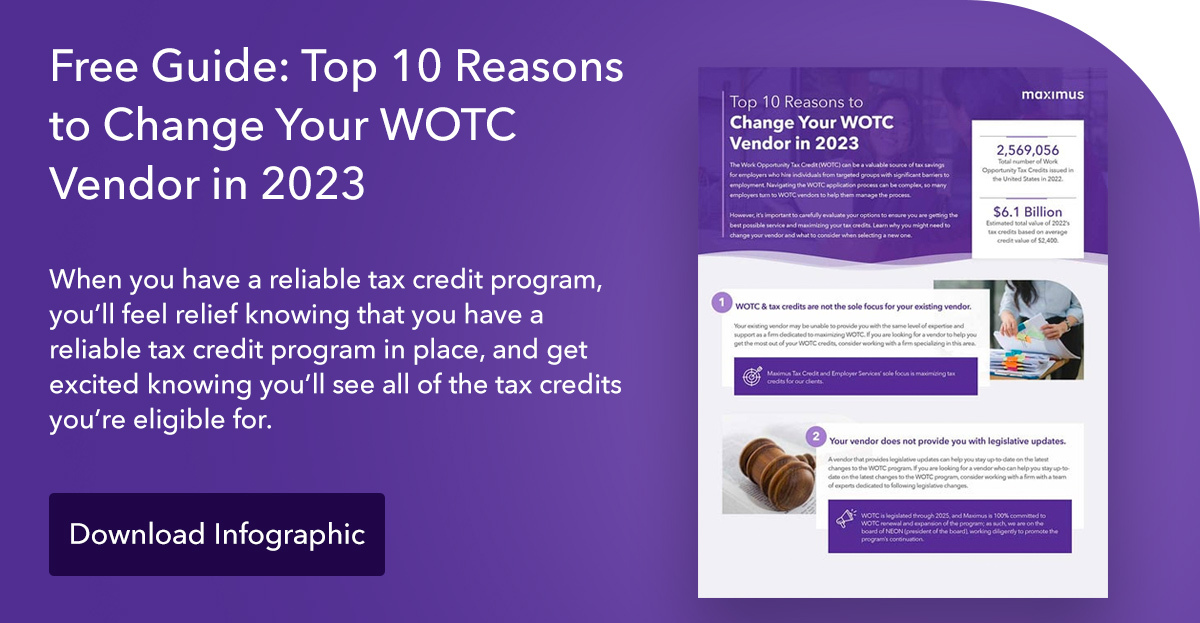What businesses need to know about claiming work opportunity tax credits

Everything You Need To Know About Claiming Work Opportunity Tax Credits: A Step-by-Step Guide
Work opportunity tax credits can save money for your business. You may be compliant already and eligible for these credits but unaware that they exist. You may not know how to claim these tax credits, which can save you between $2,400 and $9,600 per employee. This step-by-step guide will help you understand how to go about claiming work opportunity tax credits.
What Is the Work Opportunity Tax Credit?
The Work Opportunity Tax Credit (WOTC) is a federal tax credit that employers may claim if they employ people from specific groups who have difficulty gaining employment. These are 10 targeted groups with significant barriers based on certain criteria. The goal of the tax credit is to provide incentives to employers to hire people from these groups.
Any employer is eligible if they hire a worker who is certified by a designated agency as a member of one of those groups. The person must be in their first year of working with the employer and perform a minimum of 400 hours of work for the employer.
Before Hiring
An employer will give the job applicant a form to fill out as part of the hiring process. This form is ETA 9061, the WOTC Individual Characteristics Form. The applicant will provide their name, address, birth date, and Social Security number. They must answer several questions by checking the boxes that apply. They may need to provide other documentation to support their claims of being a member of a targeted group. A prime example is Veterans, Veterans who need to have a DD214 form to show their military service.
If an employer wishes to claim the WOTC, they must pre-screen their applicants and certify that the person they want to hire is a member of one of the targeted groups before they make a job offer to that person.
The employer will need to have the applicant complete a pre-screening notice, which is Form 8850 (Pre-Screening Notice and Certification Request for the Work Opportunity Credit). The applicant and employer must complete it before or on the day an offer is made for employment.
Forms To Be Completed for Eligibility
Form 8850 must be completed for claiming work opportunity tax credits, with particular attention paid to page two. On this page, the employer must specify certain dates.
- Date the applicant gave information
- Date the applicant was offered the job
- Date applicant was hired
- Date applicant started the job
To qualify for the WOTC, the date the applicant provided information that they are part of a targeted group must be prior to the date they were offered the job. The next two dates must follow the date the applicant provided information and was offered the job.
Form 8850 must be signed and submitted to the State Workforce Agency (SWA) along with ETA Form 9061 within 28 days of the date that the applicant started the job. The SWA will confirm that the applicant is a certified member of one of the targeted groups and grant qualification for the work opportunity credit to the employer.
Claiming the Credit
Once the employer receives the required certification, they can claim the credit on their income tax. If they are tax-exempt, the employer will need to claim the credit against their portion of the Social Security tax.
Submit IRS Form 5884
Both taxable and tax-exempt employers must fill out Form 5884. Tax-exempt employers must complete Ford 5884-C, Work Opportunity Credit for Qualified Tax-Exempt Organizations Hiring Qualified Veterans. This form must be filed after filing the employment tax return for that period. They shouldn’t reduce the amount they are paying on the basis of the WOTC. Instead, it will be carried forward.
Limits for the WOTC
The tax credit does have some limitations for the business. It can be carried backward only one year from the current year but forward up to 20 years. Tax-exempt organizations are limited to the amount of table wages and tips that they report for the period the credit is claimed.
The wages being used to calculate the WOTC cannot be used to calculate other credits for the business. The business can get more than one credit for the same employee as long as it is using other wages.
Targeted Groups
There are 10 groups that qualify for the WOTC.
- Qualified IV-A Recipient: A member of a family who receives assistance for at least nine of 18 months prior to the hiring date from a state program under Title IV of the Social Security Act. This relates to the TANF, Temporary Assistance for Needy Families.
- Qualified Veteran: Former military member who meets specific criteria, such as not being employed for over a year after discharge or being unemployed for the past six months out of a year with a service-connected disability.
- Qualified Ex-Felon: A person hired within a year after being convicted of a felony or released from prison.
- Designated Community Resident: Someone between 18 and 40 who is a resident of an Empowerment Zone or Rural Renewal County.
- Vocational Rehabilitation Referral: Someone with a mental or physical disability who has been referred to the employer after completing a specific program.
- Qualified Summer Youth Employee: A person between 16 and 18 who performs work for the employer during the summer and lives in an Empowerment Zone.
- Qualified Supplemental Nutrition Assistance Program Benefit Recipient: Someone between 18 and 40 and is a member of a family receiving SNAP benefits within the past six months.
- Qualified Supplemental Security Income Recipient: Someone who received SSI benefits within a 60-day period ending on the date hired.
- Long-Term Family Assistance Recipient: Certain qualified person receiving assistance under an IV-A program.
- Qualified Long-Term Unemployment Recipient: A person who has been unemployed for at least 27 weeks at the hiring date who had received unemployment compensation.
Many businesses are eligible for this credit and may not be aware of it or even know that it exists. For more information about claiming work opportunity tax credits, contact Maximus – TCES and find out if your business might qualify for WOTC.
